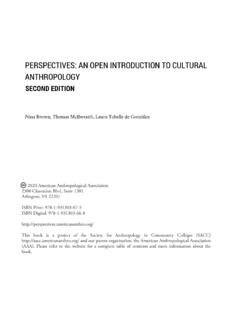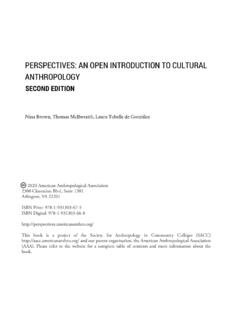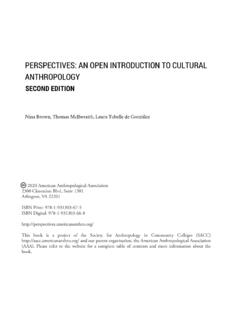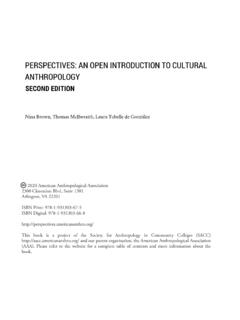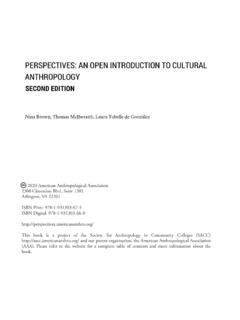Transcription of Perspectives: An Open Introduction to Cultural ...
1 PERSPECTIVES: AN OPEN Introduction TO Cultural ANTHROPOLOGY Nina Brown, Thomas McIlwraith, Laura Tubelle de Gonz lez 2020 American Anthropological Association2300 Clarendon Blvd, Suite 1301 Arlington, VA 22201 ISBN Print: 978-1-931303-67-5 ISBN Digital: 978-1-931303-66-8 book is a project of the Society for Anthropology in Community Colleges (SACC) and our parent organization, the American Anthropological Association (AAA). Please refer to the website for a complete table of contents and more information about the EDITIONP erspectives: An Open Introduction to Cultural Anthropology, 2nd Edition by Nina Brown, Thomas McIlwraith, Laura Tubelle de Gonz lez is licensed under a Creative Commons Attribution-NonCommercial International License, except where otherwise noted.
2 Under this CC BY-NC copyright license you are free to: Share copy and redistribute the material in any medium or format Adapt remix, transform, and build upon the material Under the following terms: Attribution You must give appropriate credit, provide a link to the license, and indicate if changes were made. You may do so in any reasonable manner, but not in any way that suggests the licensor endorses you or your use. NonCommercial You may not use the material for commercial purposes. 10 10 GENDER AND SEXUALITY GENDER AND SEXUALITY Carol C. Mukhopadhyay, San Jose State University Tami Blumenfield, Yunnan University with Susan Harper, Texas Woman s University, and Abby Gondek, Learning Objectives Learning Objectives Identify ways in which culture shapes sex/gender and sexuality.
3 Describe ways in which gender and sexuality organize and structure the societies in which we live. Assess the range of possible ways of constructing gender and sexuality by sharing examples from different cultures, including small-scale societies. Analyze how anthropology as a discipline is affected by gender ideology and gender norms. Evaluate Cultural origin stories that are not supported by anthropological data. Introduction : SEX AND GENDER ACCORDING TO ANTHROPOLOGISTS Anthropologists1 are f ond of pointing out that much of what w e tak e f or granted as natural in our lives is actually Cultural it is not grounded in the natural world or in biology but invented by 231 Because culture is in vented, it takes diff erent f orms in different p laces and changes over time in those places.
4 Living in the twenty-first century, w e ha ve witnessed how rapidly and dramatically culture can change, from w ays of communicating to the emergence of same-sex marriage. Similarly, man y of us live in culturally diverse settings and experience how varied human Cultural inventions can be. We r eadily accept that clothing, language, and music are Cultural invented, created, and alter-able but often find it difficult to accept that gender and sexuality are not natural but deeply embedded in and shaped by culture. W e struggle with the idea that the division of humans into two and only tw o categories, male and female, is not universal, that male and female are Cultural concepts that take different f orms and have diff erent meanings cross-culturally.
5 S imilarly, human sexuality, rather than being simply natural is one of the most culturally significant, shaped, regulated, and symbolic of all human capacities. The concept of humans as either heterosexual or homosexual is a culturally and historically specific invention that is increasingly being challenged in the United States and elsewhere. Part of the problem is that gender has a biological component, unlike other types of Cultural inven-tions such as a sewing machine, cell phone, or poem. We do have bodies and there ar e some male-female differences, including in reproductive capacities and roles, albeit far fewer than we ha ve been taught. Similarly, sexuality, sexual desires and responses, are partially r ooted in human natural capaci-ties.
6 H owever, in many w ays, sexuality and gender are lik e f ood. We ha ve a biologically r ooted need to eat to survive and we ha ve the capacity to enjoy eating. What constitutes food, w hat is delicious or repulsive, the contexts and meanings that surround f ood and human eating those are Cultural . Many potentially edible items are not food ( rats, bumblebees, and cats in the United States, f or example), and the concept of food itself is embedded in elaborate conventions about eating: how, w hen, with whom, where, utensils, f or w hat purposes? A romantic dinner at a gourmet restaurant is a complex cul-tural invention. In short, gender and sexuality, lik e eating, have biological components.
7 But cultures, o ver time, have erected complex and elaborate edifices around them, creating systems of meaning that often barely resemble what is natural and innate. We experience gender and sexuality largely thr ough the prism of the culture or cultures to which we have been exposed and in which we have been raised. In this chapter, w e ar e asking you to r eflect deeply on the ways in w hich w hat w e ha ve been taught to think of as natural, that is, our sex, gender, and our sexuality, is, in fact, deeply embedded in and shaped by our culture. W e challenge you to explore exactly w hich, if any, aspects of our gender and our sexual-ity are totally natural.
8 One powerful aspect of culture, and a reason Cultural norms feel so natural, is that we learn culture the w ay w e learn our native language: without formal instruction, in social contexts, picking it up from others around us, without thinking. Soon, it becomes deeply embedded in our brains. We no longer think consciously about what the sounds we hear when someone says hello mean unless we do not speak English. Nor is it difficult to tell the time on a clock even though time and clocks are com-plex Cultural inventions. The same principles apply to gender and sexuality. W e learn very early (b y at least age three) about the categories of gender in our culture that individuals are either male or female and that elaborate beliefs, behaviors, and meanings are associated with each gender.
9 W e can think of this complex set of ideas as a gender ideology or a Cultural model of gender. All societies have gender ideologies, just as they have belief systems about other significant areas of life, such as health and disease, the natural world, and social relationships, including family. F or an activity related to this section, see Activity 1 in the Teaching Resources of the Perspectives website. 232 PERSPECTIVES: AN OPEN Introduction TO Cultural ANTHROPOLOGYFOUNDATIONS OF THE ANTHROPOLOGY OF GENDER Gender Ideologies, Biology, and Culture Gender vs. Sex Words can reveal Cultural beliefs. A good example is the term sex. In the past, sex referred both to sexuality and to someone s biologic sex: male or female.
10 Today, although sex still refers to sexuality, gender now means the categories male, female, or increasingly, other gender possibilities. Why has this occurred? The change in terminology reflects profound alterations in gender ideology in the United States ( and elsewhere). In the past, influenced by J udeo-Christian religion and nineteenth and twentieth century scientific beliefs, biology (and r eproductive capacity) w as literally considered to be destiny. M ales and females, at least normal males and females, were thought to be born with different intellectual, physi-cal, and moral capacities, preferences, tastes, personalities, and predispositions for violence and Ironically, man y cultures, including European Christianity in the Middle Ages, viewed w omen as having a strong, often insatiable sexual drive and capacity.
